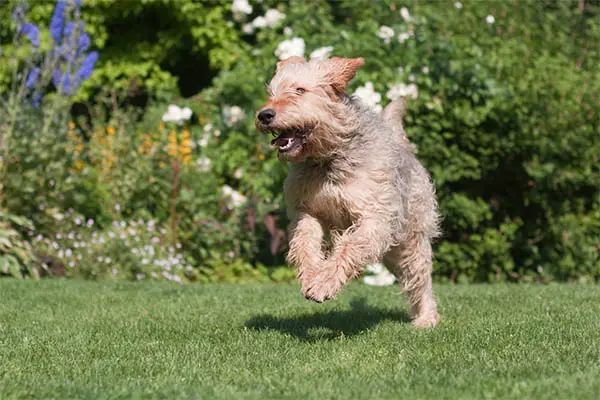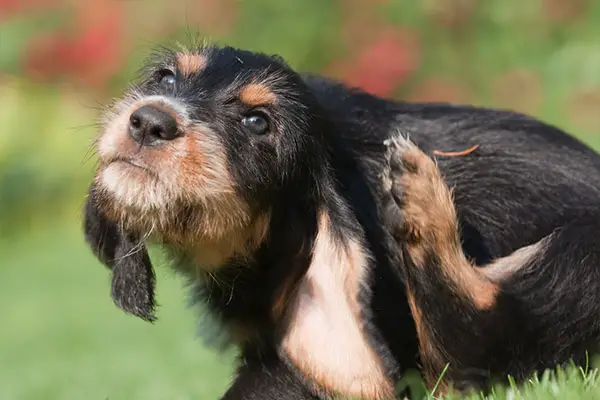The Otterhound is a large to giant-sized dog originally used to hunt otters. Their rough, waterproof coats, webbed feet, broad chest, and powerful shoulders make these dogs excellent swimmers. They are also known to have a keen sense of smell to trail an otter’s underwater smell.
These dogs, despite their size, have calm and soft personalities that make them excellent family companions. However, you should take note that it’s not easy to live with them. They are quite messy, so you need to be very patient in honing them inside the homes. Another thing you should note is that these are amiable dogs and would not make excellent watchdogs.

Otterhound Statistics
| Dog Breed Group | Hound |
| Breed Size | Large to Giant |
| Height | 27 inches (male); 24 inches (female) |
| Weight | 115 pounds (male); 80 pounds (female) |
| Lifespan | 10-13 years |
Otterhound Ratings
| Energy level | |
| Exercise needs | |
| Requires attention | |
| Playfulness | |
| Trainability | |
| Shedding | |
| Grooming | |
| Friendly with family | |
| Friendly with kids | |
| Friendly with strangers | |
| Friendly with other dogs | |
| Prey Drive |
Otterhound Dog History
Otterhounds originated from England around 1175. During this time, river otters were considered a big threat to fishers when it comes to catching fish. So, breeders developed the breed, which they refer to as “otter doggie” to hunt and destroy otters.
Soon, otter hunting became an enjoyed sport by noblemen. Royalties like Edward II, Henry Vi, Richard III, Henry VIII, King John, Charles II, Edward IV, Henry II, Henry VII, and Queen Elizabeth I became fans of the breed.
However, although “otter dogies” have been around for a long time, these dogs didn’t become a specific breed for the next 200 years. Until the 18th century, when modern otterhounds were developed from Bloodhounds and other rough-coated French dog breeds.
When the population of otters declined due to water pollution, hunting otters was also banned. This caused the disbanding of Otterhound packs, and the dogs were assigned a different job.
In the year 1900, the dogs were brought to the US, and they were first exhibited in a show in Oklahoma by 1907. By 1960, the Otterhound Club of America was formed, and the American Kennel Club recognized the breed by 1991.
Currently, the dogs rank 181st as the most popular dog breed in the US. Although they are no longer used for otter hunting, they still make excellent hunting and family companions.

Temperament
Otterhounds are even-tempered, amiable, and boisterous dogs. Despite their big size, they are easy-going dogs. They love the company of people, so expect them to be gentle with children. Though, you need to keep close supervision when it comes to toddlers.
These dogs are devoted to family, but they don’t really need your attention all the time. They are independent dogs, but they do love to play.
They are best fit in rural areas with large, securely fenced yards so they can play. They will be excellent companions if you’re the outdoorsy type, too. If there’s a lake near you, you can take him there for a swim.
Otterhounds are friendly with almost everyone, this includes other dogs and strangers. Their overly-friendly nature will not make them excellent guard dogs or watchdogs. Small pets are also not safe as these dogs have a strong prey drive.
Early socialization is needed for any kind of breed. Expose them to different people, sights, animals, and sounds so they grow up well-rounded.
Training should also be provided, especially obedience training. Remember, these dogs can be stubborn, so it’s essential to be consistent and firm to make him do what you ask.
Care Requirements
- Nutrition: Otterhounds should do well on high-quality and well-balanced meals daily. There are no special dietary requirements so stick to the standard they need, which are the essentials nutrients – proteins, fats, and carbohydrates. When serving home-cooked meals, you should make sure that you only buy high-quality ingredients. List down the best food sources of the essential nutrients your dog can get and provide this to him. Add fruits and vegetables for excellent sources of vitamins and fiber. You can also serve commercially manufactured as long as you choose the premium quality ones. The label should also say that it doesn’t contain fillers, additives, and by-products. These have very low nutritional value and might only cause complications to your dog. What you should watch out for is the number of calories you feed your dog in a day. This usually depends on your dog’s age, activity level, and metabolism. If you don’t know how to solve it, asking your vet will be the best route. Take note of any ingredients your dog is allergic to, also. If you need a feeding guide, ask one from your vet to provide the best nutrition to your Otterhound.
- Grooming: Otterhounds have medium-length shaggy coats that shed seasonally. It must be kept as natural as possible, so no trimming is needed. Instead, brushing for about one to two times a week will keep the dog’s coat healthy. Brushing will also help remove debris, keeps shedding to a minimum, and prevents mats and tangles from forming. During the shedding season, you might need to brush the coats daily, but don’t think of it as a chore as this will likely strengthen your bond with your dog. Baths can be given occasionally, but you should pay attention to their beard and clean them more often. There are cases that it will store extra food when he eats or mud/dirt will get stuck as he tries to sniff the ground. Ears should be cleaned regularly to prevent ear infection. And don’t forget to trim the nails, too, so it doesn’t become too long and cause pain and discomfort.
- Exercise: Otterhounds are energetic dogs that need regular exercise, one that would help stimulate it’s mind and body. If you have a large, securely -fenced yard, you can let them loose to run around. But what we recommend best is to play with them. These dogs will sometimes be content lying under a tree instead of exercising on it’s own, so it’s your job to guide them. In addition to play sessions, long walks will also be great.
- Health: Otterhounds are generally healthy dogs with a long lifespan. However, like many other dog breeds, they are susceptible to several diseases, and if not taken care of well, they will likely develop it. For these dogs, there are three things to worry about:
- Bloating
- Hip Dysplasia
- Canine Idiopathic Thrombocytopenia
- We highly recommend getting your dog to take some screening tests to detect certain conditions early. Another thing you can do is meeting your dog’s parents to be aware of what possible diseases your dog might acquire. We advise closely monitoring your dog’s behavior, and if you notice any changes, take him immediately to the vet.
- Lifespan: The life expectancy of Otterhounds is 10-13 years.
Fun Facts about Otterhounds
- Otterhounds originated from England as far back as the 1100s.
- They were developed to hunt and kill otters.
- The modern-day Otterhound is a mixture of Bloodhound and several rough-coated French Hound dog breeds.
- They were loved by royalties.
- They are one of the rarest breeds threatened to go extinct mainly because hunting otters is already illegal.
- These dogs were recognized by the American Kennel Club in 1991.
Check Out Other Hound Dog Breeds:
Afghan Hound, American English Coonhounds, American Foxhound, Basenjis, Basset Hound, Beagle, Black and Tan Coonhound, Bloodhound, Bluetick Coonhound, Borzois, Cirnechi dell’Etna, Dachshund, English Foxhound, Grand Basset Griffon Vendeens, Greyhound, Harrier, Ibizan Hound, Icelandic Sheepdogs, Irish Wolfhound, Norwegian Elkhound, Petit Basset Griffon Vendéen, Pharaoh Hounds, Plotts, Portuguese Podengo, Redbone Coonhound, Rhodesian Ridgeback, Salukis, Scottish Deerhounds, Sloughis, Treeing Walker Coonhound, Whippet
